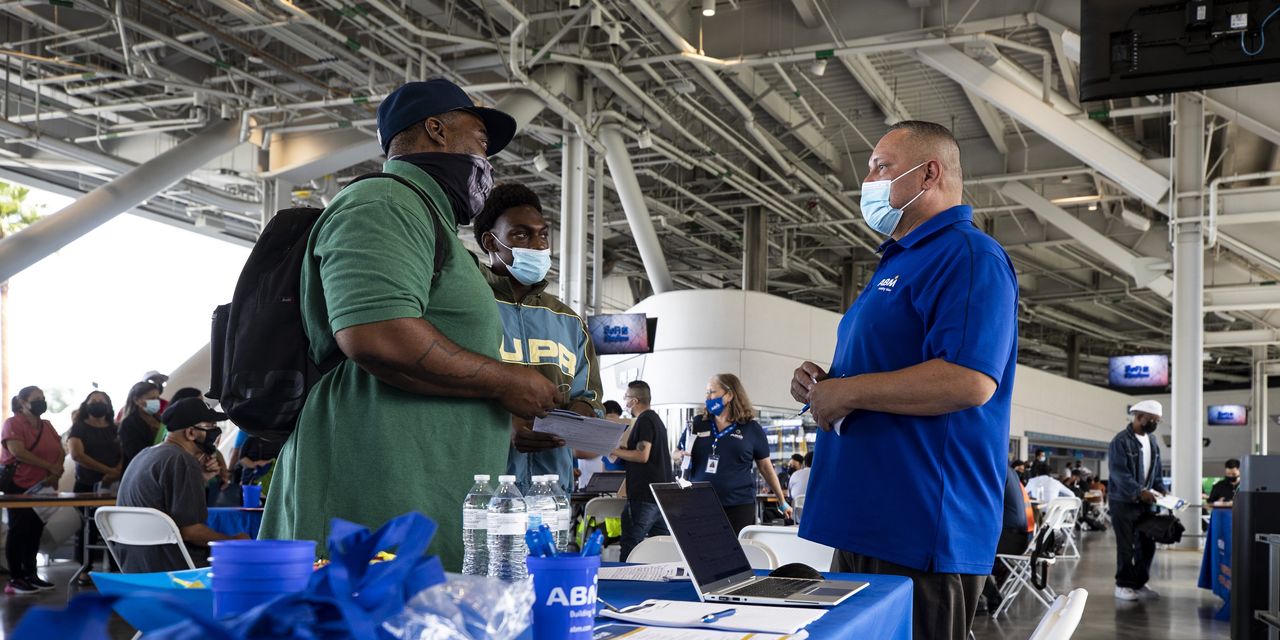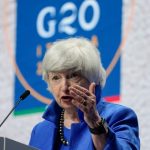
The economy created 194,000 jobs in September, the smallest gain since December 2020 and down from 366,000 jobs added in August, the Labor Department said Friday. While the September payroll gains fell well short of economists’ expectations, job growth in August was bigger than previously estimated.
Many workers gave up the job search and exited from the labor force last month, the data showed. The smaller pool of labor meant that despite the slowdown in hiring, the unemployment rate fell to 4.8% last month from 5.2% in August.
The economy is in an unusual position: Demand is strong. Households are flush with cash and have increased spending briskly this year on goods and services. But businesses are struggling to find workers to serve them, part of a broader supply squeeze that is being felt in the U.S. and globally.
“This was the time when a lot of people were expecting labor shortages to be getting better, but in fact they’re getting worse,” said Michael Pearce, senior U.S. economist at Capital Economics. “It’s a pretty worrying situation.”
U.S. stocks reacted little to the report, with the Dow Jones Industrial Average slipping 8.69 points and the S&P 500 edging down by 8.42 point
Employers added jobs at a robust pace earlier this year as vaccination rates rose and consumers ventured back out into the public. But growth slowed sharply this summer as the Delta variant, a highly contagious strain of Covid-19, prompted a new round of restrictions on businesses and spooked many would-be job seekers.
The labor market last month wasn’t entirely bleak. Private-sector employers hired at a decent clip—adding 317,000 jobs last month. But a mysterious decline in public-sector employment weighed on the overall job figure. Some economists believe the drop may have been statistical rather than real, resulting from flaws in the way the government adjusts data for seasonal factors.
Public-sector jobs, mainly at schools, fell by 123,000 last month. Most schools have reopened to host classes in person after teaching online earlier in the pandemic, but Covid outbreaks have led to temporary closures. Some previous employees may be resisting returning to work to avoid getting sick, economists said. Also, the way the government adjusts data for seasonal factors—a process complicated by hiring patterns during the pandemic—may have led to an imprecise figure for school employment.
In the private sector, employment rose modestly across several industries, including leisure and hospitality businesses, retailers and factories.
Companies are eager to hire—job openings this summer soared to a record high, government data show—but a large number of workers who left the labor force during the pandemic haven’t returned. The number of workers who cited the pandemic as the reason they didn’t look for jobs rose last month for the first time since January, reaching 1.6 million. That is a sign that fears of the Delta variant scared off many job seekers.
Other factors may include the early retirement of workers during the pandemic, and a shortage of child-care workers, which may be forcing some parents to stay at home and watch their own children rather than return to work. Also, some companies have voiced fears that workers would quit rather than comply with employer requirements to get vaccinated, while others such as United Airlines Holdings Inc. have started the process of letting go of vaccine-hesitant workers.
The jobless rate remains higher than the pre-pandemic level of 3.5%. But other measures—chiefly, wage growth—suggest the labor market is tight. The average hourly pay of private-sector workers climbed 0.6% in September from August, as employers raised wages to compete over a shrunken pool of workers. Compared with a year earlier, wages rose 4.6%, a pickup from prior months. Existing employees are also increasing the hours they work during the week to make up for the labor shortage.
Higher wages could add to inflation pressures and influence the debate within the Federal Reserve about how quickly to tighten monetary policy, economists said. Fed officials have signaled in recent weeks the job gains are likely to satisfy the thresholds they have laid out to start reducing their bond buying at their policy meeting next month.
With the expiration of enhanced jobless benefits, rising vaccination rates and higher wages, many economists predicted that workers would resume the job search. But last month, the labor-force participation rate—or the share of workers with a job or actively looking for one—dipped slightly to 61.6%, down from 63.3% in February 2020 ahead of the pandemic.
“Ramped-up production may be necessary, but you can’t find the employees to ramp it up,” said Ann Silver, head of the local Chamber of Commerce in Reno, Nev. “We’re hearing that from every sector—hospitality and touring, healthcare, you name it. People can’t be found. Everybody’s quick to say, ‘Wow, the economy is rebounding.’ Well, it can’t without human beings.”
Employers are increasingly holding on to the workers they do have, with layoffs across the U.S. declining. Applications for initial jobless claims fell by 38,000 last week to 326,000, close to a pandemic low, the Labor Department said Thursday.
At Great Basin Brewing Co.’s two restaurants in the Reno, Nev., area, managers have raised the wages of cooks by 30% since January, said co-founder Tom Young, who recently sold the company to private investors. Diners have returned to the restaurants in droves this year, but instead of seating the normal 180 patrons in each store, they will only seat a maximum of 150 due to the lack of kitchen staff, Mr. Young said. The company seeks to hire 10 people. “There aren’t enough workers to go around here,” Mr. Young said.
The No. 1 reason why people are avoiding the workforce is fear of catching the coronavirus, according to an August survey by the job-search website Indeed. Other factors include parents staying at home to care for children while some schools remained closed this year.
Schools have since reopened, but the government said hiring in that sector was lower than usual in September. “Recent employment changes are challenging to interpret, as pandemic-related staffing fluctuations in public and private education have distorted the normal seasonal hiring and layoff patterns,” the Labor Department said in its release Friday.
In one hopeful sign, Covid-19 infections have declined in recent weeks, a development that economists believe could lead to more workers eventually re-entering the labor force.
“If previous declines in case counts are any guide, the reduced salience of the pandemic will lead to more folks returning to the labor force,” said Nick Bunker, economist at Indeed.
Write to Josh Mitchell at [email protected]
Copyright ©2021 Dow Jones & Company, Inc. All Rights Reserved. 87990cbe856818d5eddac44c7b1cdeb8








